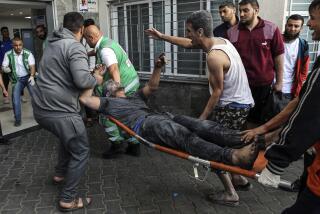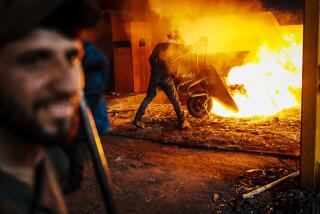U.S. now in Afghanistan as long as Soviets were
- Share via
Reporting from Kabul, Afghanistan, and Moscow — As wartime days go, Friday was a fairly quiet one in Afghanistan. Helicopters skittered across the sky; convoys rumbled along desert roads; soldiers in mountain outposts scanned the jagged peaks around them.
But one thing set the day apart: With its passing, the length of the U.S. military’s campaign in Afghanistan matched that of the Soviet Union’s long and demoralizing sojourn in the nation.
The last Red Army troops left Feb. 15, 1989, driven out after nine years and 50 days by the U.S.-backed Afghan fighters known as mujahedin, or holy warriors. Ragtag yet ferocious, they were so spectrally elusive that the Soviet forces called them dukhi, or ghosts. A fitting term, perhaps, for a country that has been called “the graveyard of empires.”
Many of the 100,000 U.S. troops deployed across Afghanistan weren’t even born then, or were too young to be aware of that distant tumult. And although Taliban leader Mullah Mohammed Omar lost an eye fighting the Soviets, many of his foot soldiers also have no real recollection of that time.
So to today’s antagonists, the Soviet war in Afghanistan is ancient history. Yet its remainders are scattered across the Afghan landscape.
The rusting hulks of Soviet aircraft and armor lie crumpled in valleys and on hills. Soviet land mines linger in the soil, even after years of mine-clearing efforts. Soviet-era infrastructure dots the country, including a strange metal runway that commercial planes still land on. The biggest U.S.-run air base, at Bagram, north of the capital, was once a key Soviet staging ground.
And history twists back on itself. In the Soviets’ war, the United States armed and aided the mujahedin; in this one, Russia is increasingly cooperating with the North Atlantic Treaty Organization. Moscow agreed this month to let the Western military alliance take armored vehicles through its territory. Last month, Russian counternarcotics agents went along on a joint NATO-Afghan drug raid.
To those who experienced it on both sides, the Soviet occupation lives on in memory.
“I will never forget the day when my motorized infantry unit entered Afghanistan,” said Andrei Logunov, then a young sergeant, later the leader of a major Russian veterans organization.
“We crossed the border from Uzbekistan without a single shot,” he recalled. “We sat on our armor and looked at the peaceful countryside all around us. Nothing could have prepared us for the bloody war that would shatter us soon enough.”
Sultan Mohammed remembers too. Now a sixtyish barber in a district outside Kabul, he spent nearly a decade battling the Soviets north of the capital, in the fight from beginning to end.
“We all together defeated them,” he said. “Every man grabbed a weapon to fight. They shouldn’t have been in our country, against our honor and culture.”
Western officials generally shun comparisons between the Soviet conflict and this one. The aims, the manner of waging the conflicts, the numbers of dead, the treatment of Afghan civilians — all these, they argue, are vastly different.
The Soviet invasion sprang from Cold War geopolitical machinations, with Moscow’s troops keeping an unpopular Communist regime in power. The U.S.-led war, targeting Al Qaeda and the Taliban, began with an air assault Oct. 7, 2001, less than a month after the Sept. 11 attacks.
For the Soviets, the scope of bloodletting in their Afghan war was enormous, with 13,833 dead troops and tens of thousands maimed. U.S. military fatalities to date total about one-tenth that: 1,403 as of Friday, according to the website icasualties.org.
The Soviet forces made scant distinction between combatants and noncombatants, and more than 1 million Afghan civilians died. U.S. counterinsurgency doctrine, in theory at least, puts protection of civilians at the forefront; even so, civilian deaths this year have run about half a dozen a day, with most blamed on the insurgency.
Despite the contrasts, the two wars have vivid narrative elements in common: An invading force finds that its vast military superiority is no guarantee of victory against a guerrilla insurgency; resentment against foreigners sometimes boils over; the terrain is timelessly formidable; local ways can seem impenetrably mysterious.
The Soviet withdrawal is a favorite public relations theme of the Taliban movement, which itself was toppled by the U.S.-led invasion in a matter of weeks, only to regroup and reinvigorate itself in recent years.
“This was their graveyard,” said Zabiullah Mujahid, a spokesman for the group. “As it will be for the Americans.”
The Taliban movement is far smaller and less broad based than the anti-Soviet mujahedin, which encompassed many ethnic groups and political factions. Nonetheless, the insurgency is expanding its territorial reach, and NATO troop casualties this year are the highest of the war.
In the eyes of some, even the Pentagon’s recent decision to deploy M1 Abrams battle tanks in southern Afghanistan evokes the David-and-Goliath confrontation of the mujahedin and the Red Army: The massive tank is seen as an effective battle weapon, but not one likely to win the hearts and minds of watching villagers.
Billions of Western dollars spent for aid and development are overshadowed, for many Afghans, by a sense that the NATO force abets corruption and graft in the government of President Hamid Karzai.
“It is better now than during the Russian period, definitely,” said Kabul shopkeeper Mohammed Omar (no relation to the Taliban leader). “But everything is for the warlords, and nothing for the poor.”
The NATO force, now on track to remain in a combat role until 2014, has lately taken an optimistic public tone about the war’s direction. President Obama declared at last week’s alliance summit in Lisbon that, militarily, “we are in a better place now than we were a year ago.”
Russian analysts and veterans, however, say the picture they see in Afghanistan is a familiar one.
“Americans haven’t drawn any lessons from the Soviet military presence; they keep stepping on the same rakes,” said Sergei Arutyunov, a senior fellow at the Institute of Ethnology and Anthropology in Moscow.
Logunov, the onetime infantry sergeant, remembers watching a live television broadcast in 1989 as the last of his compatriots crossed the bridge out of Afghanistan. Later that year, the Berlin Wall would fall, and the Soviet Union not long afterward.
“We had many toasts as we drank our vodka,” he said. “The third toast, without clinking glasses, is to those who never came back from that war, to our dead brothers-in-arms.
“Then I stood up to make the fourth toast. I said, ‘Let’s drink to my wish that men will never have to raise the third toast in the future.’ ”
King reported from Kabul and Loiko from Moscow. Special correspondent Hashmat Baktash in Afghanistan contributed to this report.
More to Read
Sign up for Essential California
The most important California stories and recommendations in your inbox every morning.
You may occasionally receive promotional content from the Los Angeles Times.










